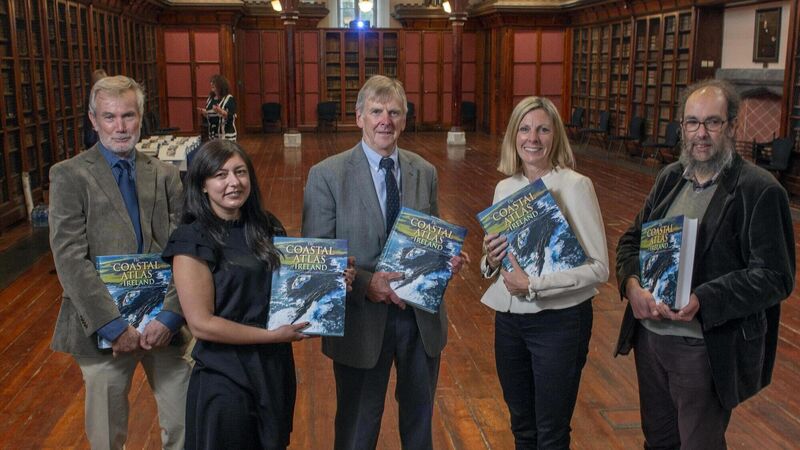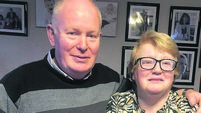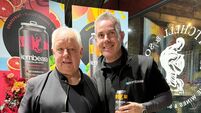Past, present, future of our coasts captured in book

In the Aula Maxima UCC for the launch of
IRELAND has a spectacular coast and, with about a million square kilometres of resources-rich marine territory, has a significant interest in world ocean affairs.
The Coastal Atlas Of Ireland examines this critical Earth and global environmental theme of the 21st century, that of coast and marine space. The book celebrates the importance of the island’s coasts at different scales, from those of local to national.
It forms the fifth, and the latest, in the now nationally and internationally acclaimed series of atlases published by Cork University Press; winning the An Post Irish Book of the Year Award in 2021, as best Irish publication.
The book has also inspired a three-part documentary series by Moondance Productions, Ireland’s Coasts, to be screened by RTÉ this autumn.
The Coastal Atlas is a little different from earlier ones, though it builds carefully on its successful predecessors in its multi-disciplinary approach. The work comprises 33 chapters, 950 pages, of fully referenced and illustrated text, produced from the work of more than 140 contributors. Their expertise spans the fields of Earth and environmental processes and patterns, geography, geodesy and information technology, geology and Earth science, archaeology, history, the social and economic disciplines, culture, art, engineering and climate science. The different elements of each of these have been used to bring to life an integrated study of this fundamental and defining element of the island.
The Atlas is designed for the general reader.
The work can be dipped into and the different topics enjoyed singly, or read more assiduously, as the reader prefers. This is not, however, simply an attractive coffee table type book. The content deals comprehensively, as a fully referenced work, with the core topics of coastal environments in Ireland and, as such, is a bench-mark type volume.
It is written in a way that the book can be used also in the study of many issues confronting the world’s coasts.
As an Atlas, it is of course full of maps, new and old! These have been produced in a fresh and contemporary style. The book also has many other types of illustrations. These include: numerous photographs, from many different sources; of people, Ireland’s ports, cities and villages, its beaches and rocks and its many stunning coastal landscapes, as well as graphs and technical diagrams.
The Atlas, whilst possibly not exhaustive in covering every different study field and topic of interest possible, does explore most.
Materials are arranged into six complementary sections. The first, entitled Coastal Systems, provides something of an overview of the themes included in the work. It starts with an introductory chapter and is accompanied by eight others. These deal with key coastal and marine topics, which range from coastal processes and functioning; marine biology and ecology; people and the coast; and, via chapters on geology, glaciation, sea-level changes and ancient shorelines, to two chapters dealing with visualising and mapping coasts and offshore areas.
Section 2, Natural Coastal Environments, picks up on the theme of the island’s major physical and biological settings. Ireland has a diversity of coastal landscapes, with about equal lengths of soft coasts, as sandy beaches and mud dominated environments, and rock dominated coasts. Both types play their part in Ireland’s key leisure, recreation and tourism industries and also have critical roles in coastal biology and ecology; as nursery grounds, habitats and reservoirs for plants and animals. The chapters in this section examine the appearances, characteristics, processes and functioning of four main settings: Rocky Coasts; Beaches and Barriers; Wetlands; Estuaries and Lagoons.
The different ways people have interacted with these natural coastal worlds, through art, design and imagination; settlements, as seen through archaeology and history; culture and heritage, is enormous.
The next ten chapters, as section 3, provide in-depth views of many of the lives and pastimes of Ireland’s coastal people, and the significance of the coast to them. Coasts have consistently formed both a gateway zone of transition as well as the launch pad to the island’s settlement. This is shown in the chapters dealing with the first known arrival of people about 14,000 years ago, and on through subsequent times, such as those of the Vikings, Normans and later, the Elizabethans; with the start of extensive urbanisation and industrialisation of core coastal areas in the 19th and early 20th centuries.
Running through these different periods occur also some unique chapters; for example, coasts and The Great Famine; the life of Ireland’s Islands; underwater cultural heritage; maritime and nautical traditions of Ireland’s seafarers, past and present.
The remaining three sections continue the treatment of these human dimensions of Ireland’s coasts into the modern era, with a focus on coastal resources, issues of economics, the impacts of technology changes, management and governance. Discussions of particular significance are of Ireland’s ports, trade, fisheries, pollution, coastal protection, mining and energy.
The final section is comprised of a single chapter, which brings together key themes from the previous 32 chapters; in examining Ireland’s coastal future.
This study looks particularly at both contemporary and future issues that are and will be increasingly of major concern for coastal people; both in Ireland and further afield. It considers especially, the likely impacts and the responses needed to meet the challenges of climate change, economic, urban and coastal management policy issues.
Overall, this Atlas is both unique, as a publication and ground-breaking, in its comprehensive and integrative view of coastal Ireland. The printed hardcopy is accompanied by a range of digital and online supports.
The Coastal Atlas of Ireland, 2021 was edited by Robert Devoy, Val Cummins, Barry Brunt, Darius Bartlett and Sarah Kandrot. Published by Cork University Press.
For more see https://www.ucc.ie/en/coastal-atlas/






 App?
App?





